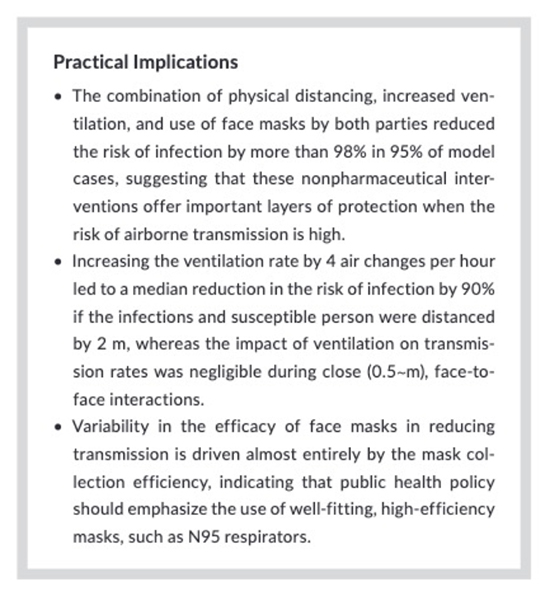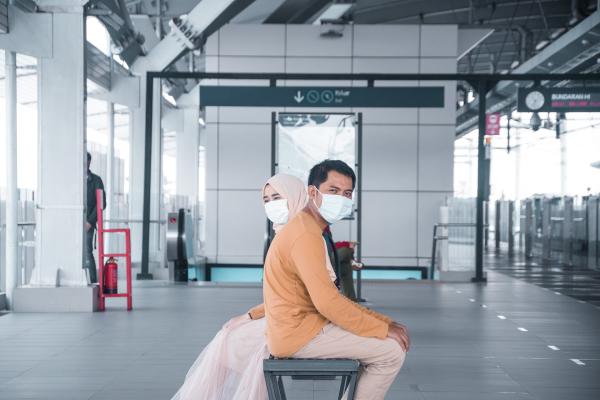The work is based upon a sophisticated mechanist model considering the risk of transmission between two individuals. One is infected and is acting as an asymptomatic transmitter, by far and away, the most likely current scenario. The computation considers 4000 combinations of a mask, ventilation, and distance in the transmission of infection from the infected to a new host.
Assumptions
The model simulates “pathogen-laden particles” expelled by the transmitter taking into account a variety of mechanical parameters. The temperature and relative humidity of the exhalation and the room’s air resulting in evaporation and increasing viral inactivation. The general force of normal exhalation and how those breaths, influenced by gravity and barriers in the room, are reflected across distances and surfaces.
Baseline room ventilation varied from 0.3 to 2.7 room changes/hour. Mask efficiency was modeled with 30 to 90% of particles removed and exhalation velocity reduced by roughly half.
The distribution of particles in the breath was assumed to be bell-shaped, more central, less peripheral, all moving in the direction of our exhalations. The risk of new infection in the uninfected host is based on exposure to a given number of particles. This particle number is an assumed value and doesn’t consider a range of physiologic variables related to susceptibility or variant infectiousness, all contributing to a critical viral load. That said, the underlying relationships between masks, distance, and ventilation should remain relatively constant; only the calculated values may change.
The considered scenarios varied the combine the three variables.
- No masks, masks on both participants, or either of them
- Distancing of 0.5, 1, and 2 meters
- Enhancing room ventilation by 4 additional room turnovers per hour from baseline.
Results
 A mask on an uninfected individual, the potential new host, reduced their risk by 50% after distancing by about 3 feet. A mask on the asymptomatic transmitter dramatically reduced risk at all distances by 90% due to diminished particles and exhalation velocity. Enhanced ventilation had little effect over short distances but decreased the risk of transmission at distances greater than 6 feet.
A mask on an uninfected individual, the potential new host, reduced their risk by 50% after distancing by about 3 feet. A mask on the asymptomatic transmitter dramatically reduced risk at all distances by 90% due to diminished particles and exhalation velocity. Enhanced ventilation had little effect over short distances but decreased the risk of transmission at distances greater than 6 feet.
Combining these layers was synergistic in reducing transmission.
If no one wore a mask, a 96% reduction in risk could be achieved with enhanced ventilation and “social distancing.” 66% could be achieved with enhanced ventilation and distancing of 3 feet.

The masking data makes it clear that it is most effective when worn by the transmitter, not the potential new host. The problem is that with the current variants, one cannot tell who is infectious or not. If both individuals wear a mask, the risk of infection is reduced by 99% without any other intervention. Masking only the transmitter, if that were possible, would reduce the risk by 80%; ventilation and distancing would reduce it still further to 95%.
What to do?
This computational model confirms what we have known for some time. High-efficiency masks, now widely available, are the best option for reducing transmission. Distancing and ventilation are often out of our control, but more ventilation allows closer distancing. Applying this to our constantly changing current situation often remains unclear and often at odds with our lived experience.
 The CDC's decision to extend the use of masks on airplanes makes little scientific sense. Complete air exchange occurs 20 times an hour; it passes through HEPA filters and is directed downward. A study by the Department of Defense found that the air exchange alone on Boeing 767s and 777s reduced transmission of “viral size” particles by 99%. But, out of an abundance of caution, the public health messaging continues to require masks on all of us because we can not easily or quickly identify asymptomatic transmitters. That is why public policy is informed by science but not based on science – that is the true meaning of “following the science.”
The CDC's decision to extend the use of masks on airplanes makes little scientific sense. Complete air exchange occurs 20 times an hour; it passes through HEPA filters and is directed downward. A study by the Department of Defense found that the air exchange alone on Boeing 767s and 777s reduced transmission of “viral size” particles by 99%. But, out of an abundance of caution, the public health messaging continues to require masks on all of us because we can not easily or quickly identify asymptomatic transmitters. That is why public policy is informed by science but not based on science – that is the true meaning of “following the science.”
Note: Since the article was written the CDC's mandate on masks on public transportation has been ended after a Federal Court ruling.
Source: High Efficacy Of Layered Controls For Reducing Exposure to Airborne Pathogens Indoor Air DOI: 10.1111/in1.12989




